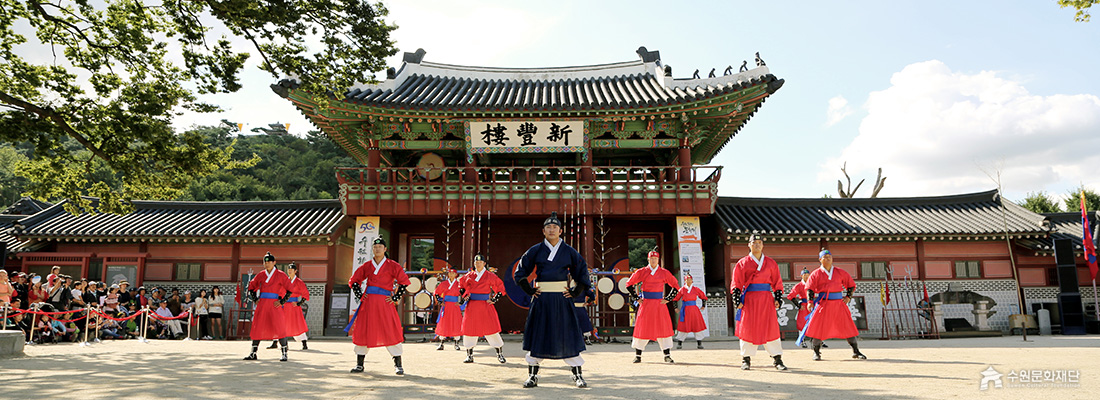Suwon City Performance Company 24 Martial Arts Trial Performance will be suspended from Monday, July 24 to Monday, August 7 due to the hot weather. The performance will resume from Tuesday, August 8 at 11 am. Please note this for your reference.
24 Martial Arts Trial Performance(muye 24 gi) in Muye Dobo Tongji which was written by actively adopting excellent martial arts of Joseon and China and Japan will be demonstrated, which will make spectators feel cool.
information
- Opening days : Tuesday~Sunday
- Opening hours : 11:00~11:30
- Place : Hwaseong Haenggung(Temporary Palace)
- Price : Free
- Constitution of 24 techniques
- Muye Dobo Tongji, Vol. 1 : jangchang, jukjangchang, gichang, dangpa, nangseon, gichang
- Muye Dobo Tongji, Vol. 2 : ssangsudo, yedo, wegeom, gyojeon
- Muye Dobo Tongji, Vol. 3 : Jedokgeom, bongukgeom, ssanggeom, masang ssanggeom, woldo, hyeopdo, deungpe
- Muye Dobo Tongji, Vol. 4 : gwonbeop, gonbang, pyeongon, masang pyeongon, gyeokgu, masangje
What is 24 Martial Arts
- What is 24 Martial Arts
24 Martial Arts(Muye 24 Gi) is the 24 martial art techniques contained in the Muye Dobo Tongji which was compiled by silhak scholars Lee Deok-mu and Park Jae-ga, and expert of martial art Baek dong-su as they were asked by King Jeongjo to do so. 24 Martial Arts were what the soldiers at the Oiyeong of Jangyongyeong, the best troop in contemporary Joseon, practiced. It is a cultural heritage high in value in artistic and athletic as well as historical senses. Soldiers stationed in Bukgunyeong, or North Military Camp, and Namgunyeong, or south Military Camp, practiced the techniques to effectively protect the haenggung. With the restoration of Hwaseong Haenggung, there is the event where the 24 techniques of martial art, which contain healthy gestures and active personalities of the Korean people, are demonstrated.
- The process in which 24 Martial Arts(Muye 24 Gi) was completed
Suffering from the Imjin Waeran, or Japanese Invasion of Korea (1592~1598), the Joseon government recognized the importance of spear-sword martial art. Then, in 1592, Han Gyo published Muyejebo, a book explaining postures and movements of Chinese martial art such as jangchang and ssangsudo with drawings and descriptions for soldiers to learn them easily. In 1604, Gwonbo was published, and, in 1610, Choi Gi-nam published Muyejebo Beonyeok Sokjip which explains eonwoldo and wegeom. Those two books were supplied to military camps. In short, after the Japanese invasion, Joseon adopted excellent martial arts of China and Japan.In those days, Korean original martial arts such as gichang, bongukgeom, and yedo were excavated, and new martial arts were invented. Around 1650 when King Hyojong was preparing for attacking Qing China, such martial arts were used as test subjects for gwageo examination for military officers. Around 1680, Kim Che-geon who mastered sword arts of the three countries ― Korea, china, Japan ― invented gyojeon, and distributed it to military camps. Gyojeon was the martial art which was perfected for the last time among the muye 24 techniques. Ordered by Crown Prince Janheonseja, Im Su-wung, drill master in the Hullyeon Dogam, compiled Muye Sinbo which summarizes 18 arts used on the ground with drawings. After King Jeongjo, son of Janheonseja, was crowned in 1776. He, following his father's will, ordered soldiers practice 18 techniques on the ground and 4 techniques on horseback. In 1785, he made such procedures into a law. King Jeongjo asked Lee Deok-mu and Park Je-ga, geomseogwans in the Gyujanggak, and Baek dong-su, chogwan, or junior officer, of the Jangyongyeong to summarize the techniques of martial art and publish it. They summarized techniques into 24 techniques ― 18 techniques on the ground and 6 techniques on horseback ― and published the Muye Dobo Tongji at the Jangyongyeong, and distributed it to military camps. Subsequently, not only the national military camps like the Jangyongyeong, the Hullryeon Dogam and the Eoyeongcheong but local military camps in eight provinces practiced muye 24 gi using Muye Dobo Tongji as the textbook.
- Lee Deok-mu and Park Jae-ga
Ordered by King Jeongjo in fall 1789, Lee Deok-mu, silhak scholar and poet in the late Joseon, together with martial artist Back Dong-su, studied the histories and origins of muye 24 techniques by referring to numerous books of the three countries — Korea, China and Japan — and published the Muye Dobo Tongji next April. Lee Deok-mu, expert in gojeunghak, or bibliographical study of Chinese classics, revealed the histories of martial arts, and Park Jae-ga, master of calligraphy, wrote the letters used for woodblocks for the book.
- Baek Dong-su
Baek Dong-su, mater of martial art, while working as chogwan at the Jangyongyeon, participated in publishing Muye Dobo Tongji. In the process of writing the book, he demonstrated 24 techniques, and directed the publication of the book.
|



















